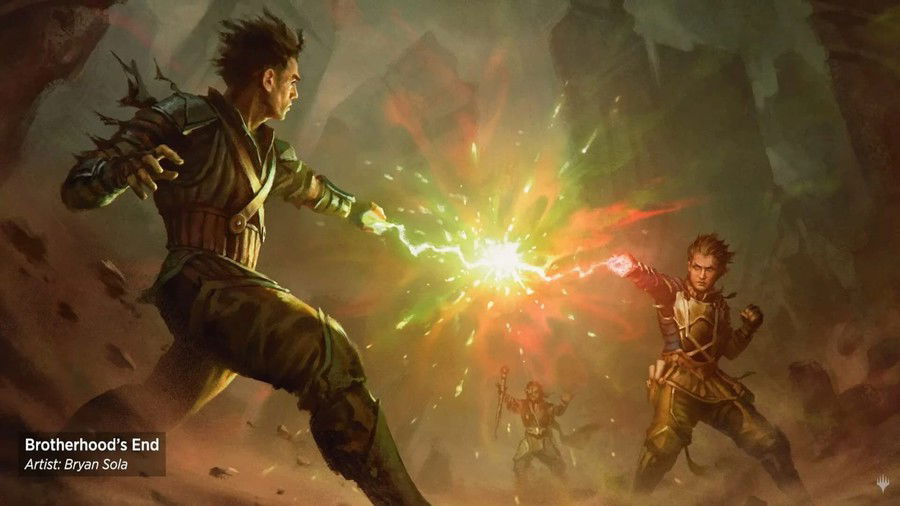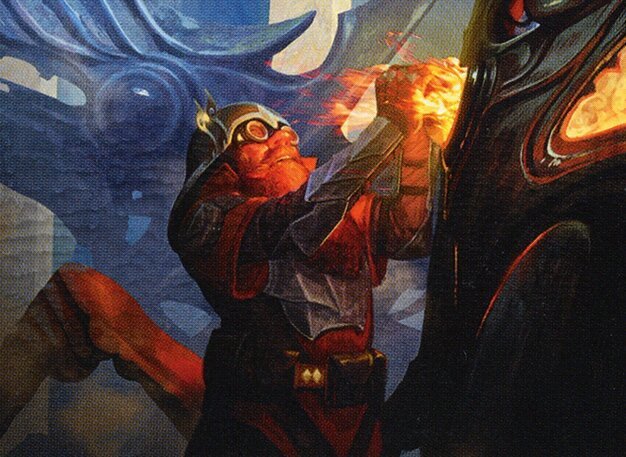This November, the Standard set of the year, The Brothers' War, was released, with the theme of the battle between Urza and Mishra, iconic characters from the history of the game.

Understanding the main keywords in The Brothers' War
In The Brothers' War we have archetypes already brought before in Magic, and we also have new themes and keywords. Here we will better understand each one.
Unearth
The Unearth ability appeared in Shards of Alara in 2006. It is an activated ability of creatures that can only be done at sorcery-speed. While the creature is in the graveyard, you can activate Unearth, making the creature to return from the graveyard to the battlefield with haste.
However, if the creature would leave the battlefield by any effect, it's exiled instead. It is also exiled at the beginning of the next end step, whichever comes first.
The set has many self-mill resources, making it easier to activate the Unearth effect.
We've already seen this ability in Shards of Alara, Modern Horizons 2, and even in Warhammer 40k commanders, such as in the cards Sedraxis Specter, Archfiend of Sorrows and Chronomancer, respectively.
In The Brothers' War, we have constructs with high mana costs, but with lower costs to Unearth, making them a threat both on the field and in the graveyard, creating doubt in their opponents if it is worth removing that threat.

And an advantage of this ability is that because you're not casting them, most counterspells doesn't interact with them as well.
Prototype
One of the new additions was cards with the Prototype ability, where you can cast an artifact creature spell for another mana cost, color, and power/toughness.
Such cards brought several possibilities in terms of blink and reanimate, since even when casting the card at the prototype cost, it maintains its types and abilities.

They are great finishers that we call “bombs”: high-cost cards that have great power or that bring an absurd game value, almost guaranteeing you a victory.
It's the first time we see this ability, and apparently it's possible to see that it's exclusive to artifact creatures. Due to their flexibility to play them early or late at your choice, in addition to being bombs if cast at full cost, they are still great cards for the early game if played at prototype cost, for example.
Powerstones
Not first seen in this set, but first seen in Dominaria United on the card Karn, Living Legacy. Powerstones are artifacts that come into play tapped from spell effects, and can only be used to cast artifact spells.

The set has many artifacts, but one of the great potential that Powerstones can deliver is to be used in activating abilities.
With that in mind, it is possible to open up a wide array of options, such as building decks that create Powerstones to pay Unearth costs or activate abilities from creatures like Urza, Prince of Kroog or Urza, Lord Protector.

As this is the second time that we see them interacting in sets, and also present in the Brothers War commanders, it may be possible to see it in future releases or even become a keyword, but this is something that we will only know in the future.
Meld
Meld has been reused on The Brothers' War, having its first appearance in Shadows over Innistrad, released in 2016, present in cards such as Gisela, the Broken Blade, Graf Rats and Hanweir Garrison.

Meld cards are two cards that, when simultaneously on the field, and also in response to what they ask to be done, become one: the card has two faces, the face of normal size, and on its back, half of the that would make a new card by just putting two together.
In The Brothers' War, we had only six cards with Meld, Mishra, Claimed by Gix, Urza, Lord Protector and Titania, Voice of Gaea, which fuse respectively with Phyrexian Dragon Engine, The Mightstone and Weakstone, and Argoth, Sanctum of Nature.

Considering that the sealed format is purely dependent on what you take from the booster packs to build your deck, it's pretty hard to get their fusion to happen. However, it's not impossible. If you manage to assemble any of them, it can be said that your chances of winning are reasonably high, considering that the fused cards have great power and board presence.
Now that we understand the set's new abilities, we can proceed to the next step of Sealed Deck building: choosing cards and their archetypes.
Archetypes in The Brothers' War
Every set is created for the limited format as well as going into others like Standard and Modern, so cards with specific effects that work well synergistically together on that environment are considered archetypes. Here we'll explore some of the existing archetypes within The Brothers' War and how they work.

Azorius Soldiers
A somewhat unusual combination considering the past, but one that seems to have come to change. In this set, we see many soldier cards, not only in white as we've always seen, but we also see a support in blue. It is possible to venture into this archetype with several Soldier-type creatures, in addition to the card advantage and control that the blue color can provide.

This archetype is not far from the good old aggro, but due to the blue additions, it is possible to fit some cards that allow you to play a slower game with card draw, bounces and counterspells.
Orzhov 3 or less
The black and white colors aren't so present together in the set, but there is a strange possibility of building them. With cards that cost 3 or less, we have good graveyard interactions and also good color blending for removals, which is essential and will be covered later.

Here we have a control that involves small reanimates to finish the opponent in the creature core. A good midrange choice.
Boros Aggro
For the surprise of no one, here we have Boros Aggro, a classic archetype of the sealed. Small creatures, buff spells, spells to get blockers out of the way and then trample your opponents.

Definitely a strong archetype, but one that fails against decks with plenty of occasional removals. Nothing that makes you worse than the others, it's just the old saying: the best defense is a good offense.
Selesnya Artifacts
This set has this very curious archetype. Usually, this color combination involves +1/+1 counters and many creatures early on, but this time we have interactions that, in addition to those mentioned now, works with artifacts.

The choice of cards here is very interesting and crucial, trying to make the most of what the archetype can offer. It's also a midrange deck, but it can be said that it's more drawn to the aggro side of things.
Dimir Draw Two
Here we have something quite different: several cards that trigger effects as soon as the second card is drawn each turn. When you think of Dimir, you hardly think of anything other than “Mana, pass” and the person playing based on responses on their turn. Although it is possible to do this in The Brothers' War, it is also important to note that drawing more than one card in the turn ends up being easier.

The first control archetype we see here, where being able to take resources from the opponent and increase yours each turn is definitely your goal.
Izzet Spells
Another classic, Izzet Spells. A deck consisting of many noncreature spells, handpicked creatures that interact with it. We have a few cards with Prowess that fit this archetype.

It is a very peculiar deck which manages to behave like all three types depending on the matchup: aggro, midrange or control.
Simic Ramp
Simic Ramp wants to cast big creatures as soon as possible. With powerstones and most of the bombs being artifact creatures, this archetype aims to hold the game as long as possible to then drop your bombs one after another.

In this archetype, don't be afraid to place 2 to 4 bombs, as the idea is to get them on board quickly. Prototype cards also shine here.
Rakdos Sacrifice
One of the most classic aggro right behind Boros is definitely Rakdos Sacrifice. Low-cost creatures with spells and/or abilities that sacrifice resources for power to achieve victory.

Unearth works perfectly on this aggro archetype, being recursive in the best way a Rakdos deck could be.
Gruul Aggro
A simple aggro. Nothing too fancy, but it does its job well. Low-cost creatures, and cheap spells for buffs and also for getting things out of the way.

Another classic aggro, being one of the easiest to pilot among all those presented.
Golgari Graveyard
Last but not least, we have Golgari Graveyard, the famous midrange/control archetype that takes advantage of self-mill and cards in the graveyard. Unearth works well here too.

Its value is always taken from dying creatures or from cards going to the graveyard, either directly from the library or the battlefield.
Best Commons
Below is a list of common ones to keep an eye on when building your deck.

Best Uncommons

Conclusion
The cards you choose, reading well the abilities present whether they are new or not, paying attention to the archetypes, choosing how many and which creatures to place, all this makes the sealed a fun format to play!
And you don't necessarily have to do everything as mentioned above either. Taking risks, adding a third color, playing more cards, everything is a possibility and the fact that this format brings many paths makes it so special.
I hope you enjoyed the reading, and if you have any questions or suggestions, let me know in the comments!














— Comments 0
, Reactions 1
Be the first to comment